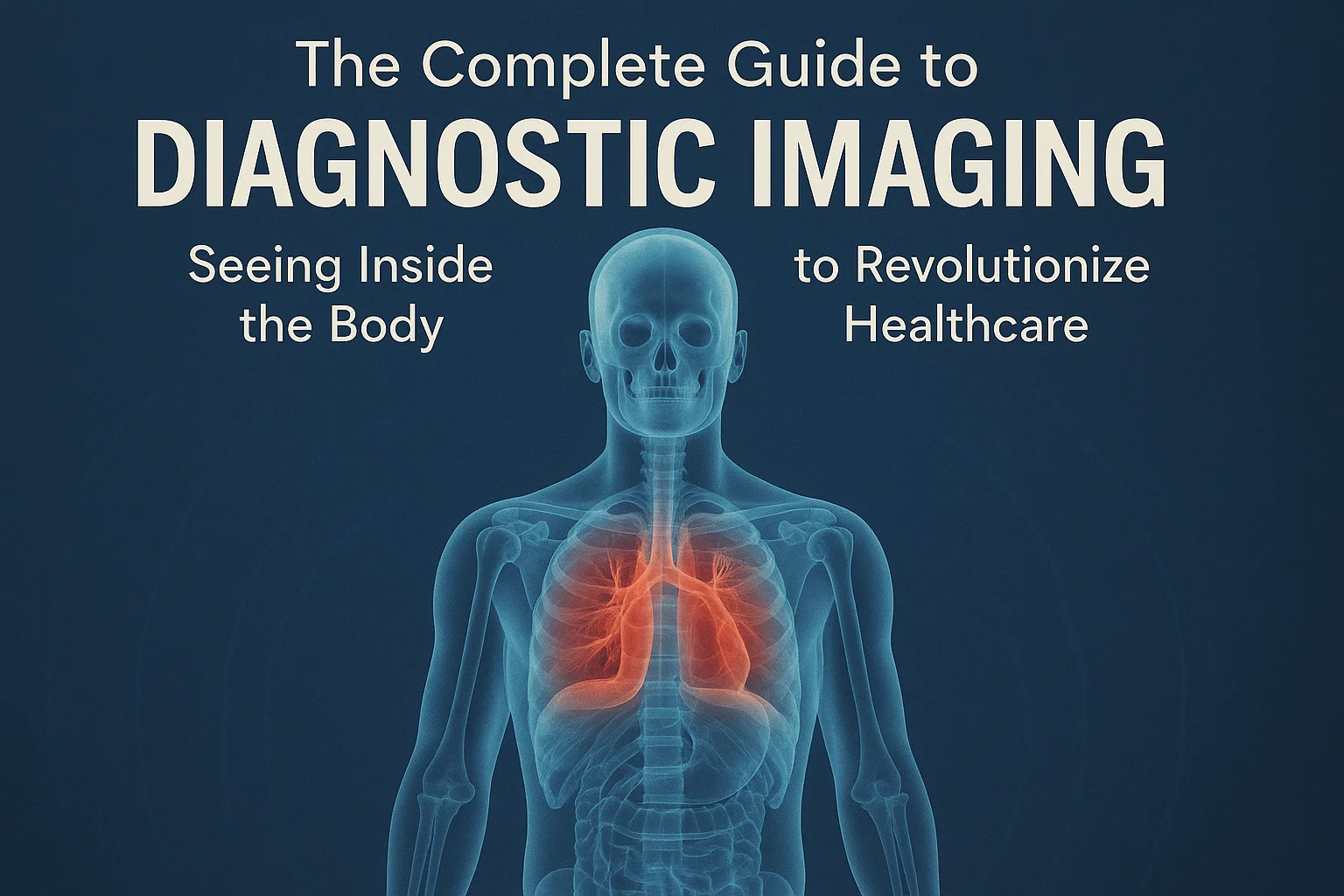The Complete Guide to Diag Image: Seeing Inside the Body to Revolutionize Healthcare
Imagine a world where a doctor had to rely solely on what you could tell them about your pain, or on their external touch, to understand a complex problem happening deep inside your body. Surgery was often the only way to confirm a diagnosis, a risky and invasive prospect. This was the reality of medicine for centuries. Then, everything changed with the advent of medical imaging—the ability to see the unseen. At the heart of this diagnostic revolution is the concept of a diag image.
A diag image, short for diagnostic image, is any visual representation of the interior of a body created for clinical analysis and medical intervention. It allows physicians to peer inside the human body without the need for invasive surgery, providing a detailed view of bones, organs, tissues, and blood vessels. These images are the cornerstone of modern medicine, forming the basis for accurate diagnoses, effective treatment planning, and ongoing patient monitoring. From a simple fractured wrist to the complex mapping of a brain tumor, the diag image is an indispensable tool that saves countless lives every single day. This guide will take you on a deep dive into the world of diagnostic imaging, exploring its various technologies, its critical role in healthcare, and what the future holds.
What Exactly is a Diag Image?
At its core, a diag image is a picture with a purpose. It’s not a snapshot for a photo album; it’s a data-rich, clinical tool designed to reveal the hidden secrets of the human body. The primary objective of any diagnostic image is to identify the cause of a medical problem, confirm a suspected condition, or rule out potential issues. It transforms subjective symptoms into objective visual evidence, creating a common ground for understanding between patient and doctor.
The creation of a diag image involves capturing data using various forms of energy—such as X-rays, sound waves, magnetic fields, or radioactive tracers—and then processing that data into a format that a trained specialist can interpret. Radiologists are the doctors who specialize in decoding this visual language. They analyze the shades of gray, the contrasts, the shapes, and the textures within each diag image to provide a detailed report that guides your primary physician in determining the best course of action for your health.
The Evolution of Diagnostic Imaging
The journey to today’s sophisticated imaging suites began with a monumental accident. In 1895, German physicist Wilhelm Conrad Röntgen was experimenting with cathode-ray tubes when he noticed a mysterious glow coming from a chemically coated screen nearby. He realized that invisible rays from the tube were passing through most objects, including human tissue, but were blocked by denser materials like bone. He captured the first-ever diag image—an X-ray of his wife’s hand, complete with her wedding ring. The world was captivated by this ability to see the living skeleton, and medicine was forever transformed.
This breakthrough sparked over a century of relentless innovation. The 1950s and 60s saw the development of ultrasound, using sound waves to visualize soft tissues and monitor pregnancies. The 1970s were a true watershed moment with the invention of the CT (Computed Tomography) scanner by Godfrey Hounsfield and Allan Cormack, which combined X-rays with computer processing to create cross-sectional diag image slices of the body. Soon after, MRI (Magnetic Resonance Imaging) emerged, offering unparalleled detail of soft tissues without any ionizing radiation. Each decade has brought refinements, from digital sensors replacing photographic film to the powerful 3D and functional imaging we have today.
A Deep Dive into Different Types of Diag Image Technologies
The term “diag image” is an umbrella term that covers a wide array of technologies. Each modality has its unique principles, strengths, and ideal use cases. Understanding these differences helps in appreciating why a doctor might order one type of scan over another.
X-Ray: The Foundation of Imaging
The X-ray is the most familiar and widely used form of diagnostic imaging. It works by passing a small, controlled dose of ionizing radiation through the body. Denser structures, such as bones, absorb more radiation and appear white on the resulting diag image. Softer tissues, which allow more radiation to pass through, appear in shades of gray and black. This makes X-rays exceptionally good for identifying fractures, infections, and tumors in bones, as well as detecting certain lung conditions like pneumonia.
While incredibly useful, standard X-rays have limitations. They provide a two-dimensional view of a three-dimensional structure, which can sometimes cause overlapping anatomy to hide fractures or other issues. They also offer limited detail for soft tissues like muscles, ligaments, or the brain. Despite these limitations, its speed, accessibility, and low cost ensure the X-ray remains a vital first-line diagnostic tool in emergency rooms and clinics worldwide.
Computed Tomography (CT) Scans
If an X-ray is a simple photograph, a CT scan is a detailed, layered sculpture. A CT scanner rotates an X-ray source around the patient, capturing multiple images from different angles. A powerful computer then processes these images to generate cross-sectional, slice-like views of the body. These slices can be stacked together to create a highly detailed 3D diag image that allows radiologists to isolate and examine specific organs, blood vessels, or bones with incredible clarity.
CT scans are invaluable in trauma situations because they can quickly provide a comprehensive overview of internal injuries, such as bleeding in the brain, organ damage, or complex fractures. They are also crucial for cancer detection, staging, and guiding biopsies and radiation therapy. However, the trade-off for this detailed view is a significantly higher dose of ionizing radiation compared to a standard X-ray. Doctors always weigh the clinical benefits of obtaining a critical diag image against the risks of radiation exposure.
Magnetic Resonance Imaging (MRI)
MRI operates on a completely different principle than X-ray or CT. Instead of radiation, it uses a powerful magnetic field and radio waves to manipulate the natural magnetic properties of atoms in your body, primarily hydrogen in water and fat. The scanner detects the energy released by these atoms and uses it to construct an exceptionally detailed diag image of soft tissues. It excels at showing the difference between normal and abnormal tissue.
This makes MRI the gold standard for imaging the brain and spinal cord, joints (like knees and shoulders), muscles, ligaments, and pelvic organs. It is indispensable for diagnosing neurological conditions (e.g., multiple sclerosis, strokes), torn ligaments, and many cancers. The process is non-invasive and does not use ionizing radiation, but it can be lengthy (often 30-60 minutes), loud, and requires the patient to remain perfectly still. It is also not suitable for people with certain metallic implants like pacemakers.
Ultrasound Imaging
Ultrasound, also known as sonography, uses high-frequency sound waves that are inaudible to humans. A transducer (probe) placed on the skin emits these sound waves and listens for the returning echoes as they bounce off internal structures. The pattern of these echoes is translated in real-time into a diag image on a monitor. This technology is best known for its role in obstetrics, allowing parents to see their developing baby, but its applications are far broader.
It is extremely effective for examining abdominal organs (liver, kidneys, gallbladder), the heart (echocardiogram), and blood flow (Doppler ultrasound). A major advantage is that it is real-time, radiation-free, and generally less expensive than CT or MRI. Its primary limitation is that sound waves do not travel well through air or bone, making it less useful for imaging the lungs or adult brain, though it is used for imaging the brains of infants whose skulls have not fully fused.
Nuclear Medicine and PET Scans
This branch of imaging involves introducing a small amount of radioactive material, called a radiopharmaceutical or tracer, into the patient’s body, usually via injection. This tracer accumulates in the specific organ or tissue of interest. A special camera (gamma camera or PET scanner) then detects the radiation emitted and creates a diag image that reveals both structure and, more importantly, function.
A Positron Emission Tomography (PET) scan is a premier example. It often uses a radioactive sugar compound because cancer cells, which are highly active, consume this sugar at a much higher rate than normal cells. This causes them to “light up” on the resulting diag image. PET scans are therefore unparalleled for detecting cancer, seeing if it has spread, and checking if treatment is working. They are often combined with a CT scan (PET/CT) to overlay the functional data onto a detailed anatomical map
Inspirational Sunday Morning Blessings Embracing the Day with Positivity
.
Table: Comparison of Major Diagnostic Imaging Modalities
| Modality | How It Works | Best For | Key Considerations |
|---|---|---|---|
| X-Ray | Ionizing Radiation | Bones, Chest, Fractures | Fast, cheap, low radiation, limited soft tissue detail |
| CT Scan | Rotating X-rays + Computer | Trauma, Cancer, Detailed Anatomy | Detailed 3D views, higher radiation dose |
| MRI | Magnetic Fields & Radio Waves | Brain, Joints, Soft Tissues | Excellent soft tissue contrast, no radiation, long scan time |
| Ultrasound | High-Frequency Sound Waves | Babies, Abdomen, Heart, Blood Flow | Real-time, no radiation, limited by bone/air |
| PET Scan | Radioactive Tracers | Cancer, Metabolic Function | Shows cellular activity, involves radiation, often combined with CT |
The Critical Role of a Diag Image in Modern Medicine
The impact of diagnostic imaging extends far beyond the radiology department. It is woven into the entire fabric of patient care, influencing every step from initial suspicion to final follow-up. The primary and most obvious role of a diag image is in diagnosis. When a patient presents with symptoms, the image provides the evidence to move from a list of potential differential diagnoses to a confirmed, specific condition. This accuracy is the first and most critical step in healing.
Furthermore, diagnostic imaging is the backbone of treatment planning and guidance. For a surgeon, a detailed CT or MRI diag image is like a map before a journey, allowing them to plan the safest and most effective surgical approach. During procedures, real-time imaging like fluoroscopy (a continuous X-ray) or ultrasound is used to guide instruments with precision, minimizing damage to surrounding healthy tissue. After treatment, follow-up scans provide objective evidence of whether a treatment is working—for example, showing if a tumor is shrinking in response to chemotherapy—allowing doctors to adjust courses of action dynamically.
What to Expect During Your Diag Image Procedure
The experience of getting a diagnostic scan can vary widely, but knowing what to expect can alleviate much of the anxiety associated with it. The process almost always begins with a referral from your doctor. You will then schedule an appointment at a hospital or outpatient imaging center. When you arrive, you will typically check in and be asked to fill out a safety screening form. This is crucial, especially for MRI (which asks about metal implants) and CT/X-ray (which asks about pregnancy).
Preparation is key and depends entirely on the type of scan. For some, like a standard X-ray of an extremity, there may be no preparation at all. For an abdominal ultrasound, you might be asked to fast for several hours beforehand. A CT or MRI scan might require the use of a contrast agent—a special dye administered orally or intravenously—to make certain structures or blood vessels stand out more clearly in the diag image. It’s essential to follow all preparation instructions carefully, as failure to do so could result in a poor-quality scan or the need to reschedule.
“Diagnostic imaging is the eyes of medicine. It allows us to move from educated guesses to informed certainty, fundamentally changing the patient’s journey for the better.” — Dr. Eleanor Vance, Chief of Radiology.
During the scan itself, a radiologic technologist—a highly trained professional—will position you on a table and operate the scanner from an adjacent room, communicating with you via an intercom. For most scans, you simply need to lie still and occasionally hold your breath as instructed to prevent motion blur in the diag image. The technologist’s goal is to acquire the best possible images while ensuring your comfort and safety throughout the process.
Understanding and Interpreting Your Results
After the scan is complete, the work of interpretation begins. The technologist processes the images and sends them to a radiologist. This medical doctor, specialized in diagnosing and treating diseases using medical imaging, meticulously analyzes every detail of your diag image. They compare the images to prior studies if available, and compile their findings into a formal written report.
This radiology report is a technical document written for your referring physician. It typically includes sections on the reason for the exam, the techniques used, a detailed description of what was seen (or not seen) in the images, an impression or conclusion that summarizes the findings, and recommendations for any further imaging if needed. It’s important to remember that the radiologist’s report is a piece of the puzzle. Your primary care doctor or specialist will combine this report with your clinical history, physical exam, and lab results to give you a complete picture of your health and discuss the next steps with you.
The Future of Diagnostic Imaging
The field of diagnostic imaging is not standing still; it is accelerating into an exciting future powered by artificial intelligence and cutting-edge technology. Artificial Intelligence (AI) and machine learning are poised to make the biggest impact. AI algorithms can be trained on millions of diag image studies to learn patterns of disease. They can act as powerful assistants to radiologists, helping to prioritize critical cases, flag potential abnormalities a human eye might miss, and even make precise measurements, reducing workload and improving diagnostic consistency.
Another major trend is the move towards quantitative imaging and personalized medicine. Instead of just a qualitative picture, future diag image technology will provide precise, measurable data on tissue characteristics, tumor density, and blood flow. This will allow treatments to be tailored to an individual’s specific disease profile. Furthermore, advancements in hardware are leading to scanners that are faster, quieter, and more patient-friendly. Low-dose CT and photon-counting CT technology are dramatically reducing radiation exposure without sacrificing image quality, making follow-up scans safer for patients.
Conclusion
From the accidental discovery of the X-ray to the AI-powered reading rooms of tomorrow, the journey of the diag image is a testament to human ingenuity and its relentless pursuit of better health. It is a field that has fundamentally dismantled the wall between the external and internal self, granting medicine the profound gift of sight. A simple diag image is more than just a film or a digital file; it is a story, a map, a key, and a lifeline. It is the objective evidence that transforms uncertainty into action, fear into understanding, and disease into recovery. As technology continues to evolve, the clarity, safety, and power of these images will only grow, ensuring that this vital tool remains at the forefront of healing for generations to come.
Frequently Asked Questions (FAQs)
What does a diag image show?
A diag image shows the internal structures of your body to help diagnose medical conditions. What it reveals depends on the type of scan. It can show broken bones, muscle tears, tumors, blockages in blood vessels, brain abnormalities, the development of a fetus, and how well your organs are functioning. The purpose is to provide a visual representation that a radiologist can analyze to find the cause of your symptoms or monitor a known condition.
Are there any risks associated with getting a diag image?
The risks vary by imaging type. X-rays and CT scans use ionizing radiation, which carries a small, potential long-term risk of cancer, but the dose is carefully controlled and the benefit of an accurate diagnosis almost always outweighs this minimal risk. MRI and ultrasound do not use ionizing radiation and are considered very safe. Some exams involve contrast agents, which have a very small risk of allergic reaction. It’s important to discuss any concerns, especially about pregnancy or allergies, with your doctor and the technologist before the scan.
How long does it take to get results from a diag image?
The time it takes to get results can vary. For a critical finding in an emergency room, a radiologist may provide a preliminary read within an hour. For routine outpatient scans, it typically takes 24 to 48 hours for the radiologist to finalize the official report and send it to your referring doctor. Your doctor’s office will then contact you to discuss the results, which may add more time. You should always ask your doctor when you can expect to hear about your results.
Why would a doctor order more than one type of imaging test?
Doctors order different tests because each modality provides unique information. One diag image might identify a problem, while another characterizes it further. For example, an X-ray might find a spot on a lung, but a CT scan would provide a more detailed view of its size and shape, and a PET scan could then determine if it is metabolically active (suggesting cancer). Each test builds upon the last to create a complete diagnostic picture and guide the most effective treatment plan.
What is the difference between a screening and a diagnostic diag image?
A screening diag image is a preventive test performed on people who have no symptoms, aiming to catch a disease early. Examples include a mammogram for breast cancer screening or a low-dose CT scan for longtime smokers to screen for lung cancer. A diagnostic diag image, on the other hand, is used to investigate the cause of specific symptoms or abnormalities found during a screening or physical exam. Diagnostic exams are often more detailed and targeted than screening exams.


